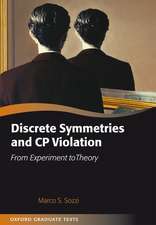The Crab Nebula: International Astronomical Union Symposia, cartea 46
Editat de R.D. Davies, F. G. Smithen Limba Engleză Paperback – 6 noi 2011
Din seria International Astronomical Union Symposia
-
 Preț: 132.74 lei
Preț: 132.74 lei -
 Preț: 404.67 lei
Preț: 404.67 lei -
 Preț: 400.65 lei
Preț: 400.65 lei -
 Preț: 412.95 lei
Preț: 412.95 lei - 15%
 Preț: 660.68 lei
Preț: 660.68 lei - 15%
 Preț: 654.43 lei
Preț: 654.43 lei -
 Preț: 407.98 lei
Preț: 407.98 lei - 18%
 Preț: 1238.74 lei
Preț: 1238.74 lei - 15%
 Preț: 659.53 lei
Preț: 659.53 lei -
 Preț: 409.89 lei
Preț: 409.89 lei - 18%
 Preț: 1556.77 lei
Preț: 1556.77 lei - 18%
 Preț: 1852.43 lei
Preț: 1852.43 lei - 18%
 Preț: 1235.57 lei
Preț: 1235.57 lei -
 Preț: 419.14 lei
Preț: 419.14 lei -
 Preț: 414.52 lei
Preț: 414.52 lei -
 Preț: 417.41 lei
Preț: 417.41 lei - 15%
 Preț: 647.73 lei
Preț: 647.73 lei - 18%
 Preț: 967.56 lei
Preț: 967.56 lei - 18%
 Preț: 1236.06 lei
Preț: 1236.06 lei -
 Preț: 407.39 lei
Preț: 407.39 lei - 15%
 Preț: 654.12 lei
Preț: 654.12 lei -
 Preț: 416.26 lei
Preț: 416.26 lei - 18%
 Preț: 960.78 lei
Preț: 960.78 lei - 18%
 Preț: 1239.67 lei
Preț: 1239.67 lei - 18%
 Preț: 1239.85 lei
Preț: 1239.85 lei -
 Preț: 416.26 lei
Preț: 416.26 lei -
 Preț: 421.82 lei
Preț: 421.82 lei - 18%
 Preț: 1238.42 lei
Preț: 1238.42 lei -
 Preț: 416.26 lei
Preț: 416.26 lei -
 Preț: 405.28 lei
Preț: 405.28 lei - 18%
 Preț: 1220.54 lei
Preț: 1220.54 lei - 18%
 Preț: 1239.19 lei
Preț: 1239.19 lei - 18%
 Preț: 961.41 lei
Preț: 961.41 lei -
 Preț: 407.39 lei
Preț: 407.39 lei - 18%
 Preț: 961.86 lei
Preț: 961.86 lei - 15%
 Preț: 652.49 lei
Preț: 652.49 lei - 18%
 Preț: 1238.74 lei
Preț: 1238.74 lei - 18%
 Preț: 962.49 lei
Preț: 962.49 lei
Preț: 403.53 lei
Nou
Puncte Express: 605
Preț estimativ în valută:
77.23€ • 80.01$ • 64.45£
77.23€ • 80.01$ • 64.45£
Carte tipărită la comandă
Livrare economică 22 martie-05 aprilie
Preluare comenzi: 021 569.72.76
Specificații
ISBN-13: 9789401030892
ISBN-10: 9401030898
Pagini: 496
Ilustrații: XIX, 470 p.
Dimensiuni: 170 x 244 x 26 mm
Greutate: 0.78 kg
Ediția:Softcover reprint of the original 1st ed. 1971
Editura: SPRINGER NETHERLANDS
Colecția Springer
Seria International Astronomical Union Symposia
Locul publicării:Dordrecht, Netherlands
ISBN-10: 9401030898
Pagini: 496
Ilustrații: XIX, 470 p.
Dimensiuni: 170 x 244 x 26 mm
Greutate: 0.78 kg
Ediția:Softcover reprint of the original 1st ed. 1971
Editura: SPRINGER NETHERLANDS
Colecția Springer
Seria International Astronomical Union Symposia
Locul publicării:Dordrecht, Netherlands
Public țintă
ResearchCuprins
Session 1 / Observations of the Crab Nebula.- 1.1 Optical Observations of the Crab Nebula.- 1.2 Dynamics of the Crab Nebula.- 1.3 The Electromagnetic Spectrum of the Crab Nebula.- 1.4 Searches for ?-Rays from the Crab Nebula and Its Pulsar.- 1.5 X-Ray Observations of the Crab Nebula.- 1.6 Upper Limit of the X-Ray Polarization of the Crab Nebula.- 1.7 Recent Results on the Search for 1011 eV Gamma Rays from the Crab Nebula.- 1.8 High Resolution Maps of the Crab Nebula at 2700 MHz and 5000 MHz.- Session 2 / Observations of the Crab Pulsar.- 2.1 Radio Observations of the Crab Nebula Pulsar.- 2.2 X-Ray Observations of NP 0532.- 2.3 Optical Observations of the Crab Pulsar, and Searches for Other Optical Pulsars.- 2.4 The Relation of the Low Frequency Source to the Crab Pulsar.- 2.5 Individual Radio Pulses from NP 0531.- 2.6 Pulsar NP 0532: Recent Results on Strong Pulses Obtained at Arecibo.- 2.7 Radio Observations of the Crab Pulsar at 408, 240 and 151 MHz.- 2.8 Time Variability of the Dispersion of the Crab Nebula Pulsar.- 2.9 Faraday Rotation of the Crab Pulsar Radiation.- 2.10 Timing of Optical Pulses from the Crab Nebula Pulsar.- 2.11 Timing Observations of the Crab Nebula Pulsar at the Arecibo Observatory.- 2.12 A Search for Variations in the Intensity of the Optical Pulses from NP 0532.- 2.13 Results of Optical Timing Measurements of the Crab Nebula Pulsar.- 2.14 Optical Timing of the Crab Nebula Pulsar NP 0532 (Abstract).- 2.15 Photometry and Polarimetry of the Crab Pulsar.- 2.16 Measurement of the Circular Polarization of Pulsar NP 0532.- 2.17 Search for Pulsed High Energy Gamma Radiation from NP 0532.- Session 3 / Observations of Other Pulsars.- 3.1 The Galactic Population of Pulsars.- 3.2 The Comparative Properties of the Pulsars.- 3.3 Polarization of Pulsars.-3.4 Observations of Pulsar Spectra.- 3.5 Polarization Measurements of Other Pulsars at Jodrell Bank.- 3.6 Crab Pulsar Radiation Characteristics.- 3.7 Timing of the Pulsar NP 0527.- 3.8 Interstellar Scattering and the Pulse from the Vela Pulsar.- 3.9 Searches for Optical Pulsars.- 3.10 Results of a Search for Visible Pulsars.- 3.11 Magnetism in White Dwarfs.- 3.12 Optical Pulsar in NGC 4254 (Summary).- Session 4 / Relation of Crab Nebula to Other Supernova Remnants.- 4.1 Comments on Supernova Remnants and Ancient Novae.- 4.2 Radio Emission from Supernova Remnants.- 4.3 Cassiopeia A — the Youngest Known Galactic Supernova Remnant.- 4.4 The Secular Behavior of X-Ray and Radio Emission from Supernova Remnants.- 4.5 Pulsars and Close Binary Systems.- Session 5 / Physics of the Crab Nebula.- 5.1 Plasma Interactions in the Crab Nebula.- 5.2 Radio Polarization of the Crab Nebula.- 5.3 Transfer of Energy to the Crab Nebula Following the Spin-Up of the Pulsar.- 5.4 Radiative Ionization of the Filaments in the Crab Nebula.- 5.5 Synchrotron Radiation in High Magnetic Fields.- Session 6 / Physics of the Neutron Star.- 6.1 Physics of the Neutron Star.- 6.2 General Relativistic Theory of Rotating Neutron Stars — A Review.- 6.3 Dynamical Stability of Neutron Stars.- 6.4 Models of Rotating Neutron Stars in General Relativity.- 6.5 The Effects of Nuclear Forces on the Maximum Mass Limit of Neutron Stars.- 6.6 Nuclear Forces in High Density Matter.- 6.7 Periodicity and Luminosity of the ‘Pulsar’ Model of Quasars.- 6.8 Multiple Pulsar Ejection in Supernova Events.- 6.9 Emission of Gravitational Waves from the Pulsar (Summary).- 6.10 Young Pulsars — Pulsed Neutron Sources.- Session 7 / Energy Considerations and the Electrodynamic Link between the Pulsar and the Nebula.- 7.1Relationship between Pulsar and Nebula.- 7.2 A Magnetic Dipole Model for the Crab Explosion (Summary).- 7.3 Physical Processes and Parameters in the Magnetosphere of NP 0532.- 7.4 The Non-Thermal Continuum from the Crab Nebula: the ‘Synchro-Compton’ Interpretation.- 7.5 Maser Theory of Pulsar Radiation.- Session 8 / Radiation Mechanisms of the Pulsar.- 8.1 The Radiation Mechanism in Pulsars.- 8.2 Pulsar Models and Radiation Properties (Summary).- 8.3 Low Mode Coherent Synchrotron Radiation and Pulsar Models.- 8.4 Radiation from Pulsars.- 8.5 Radiation Beaming in Pulsars.- 8.6 Low-Frequency Cutoffs in Synchrotron Spectra and the Optical Spectrum of NP 0532.- 8.7 Pulsar (and X-Star) Emission from the Magnetosphere of a Collapsed Star.















